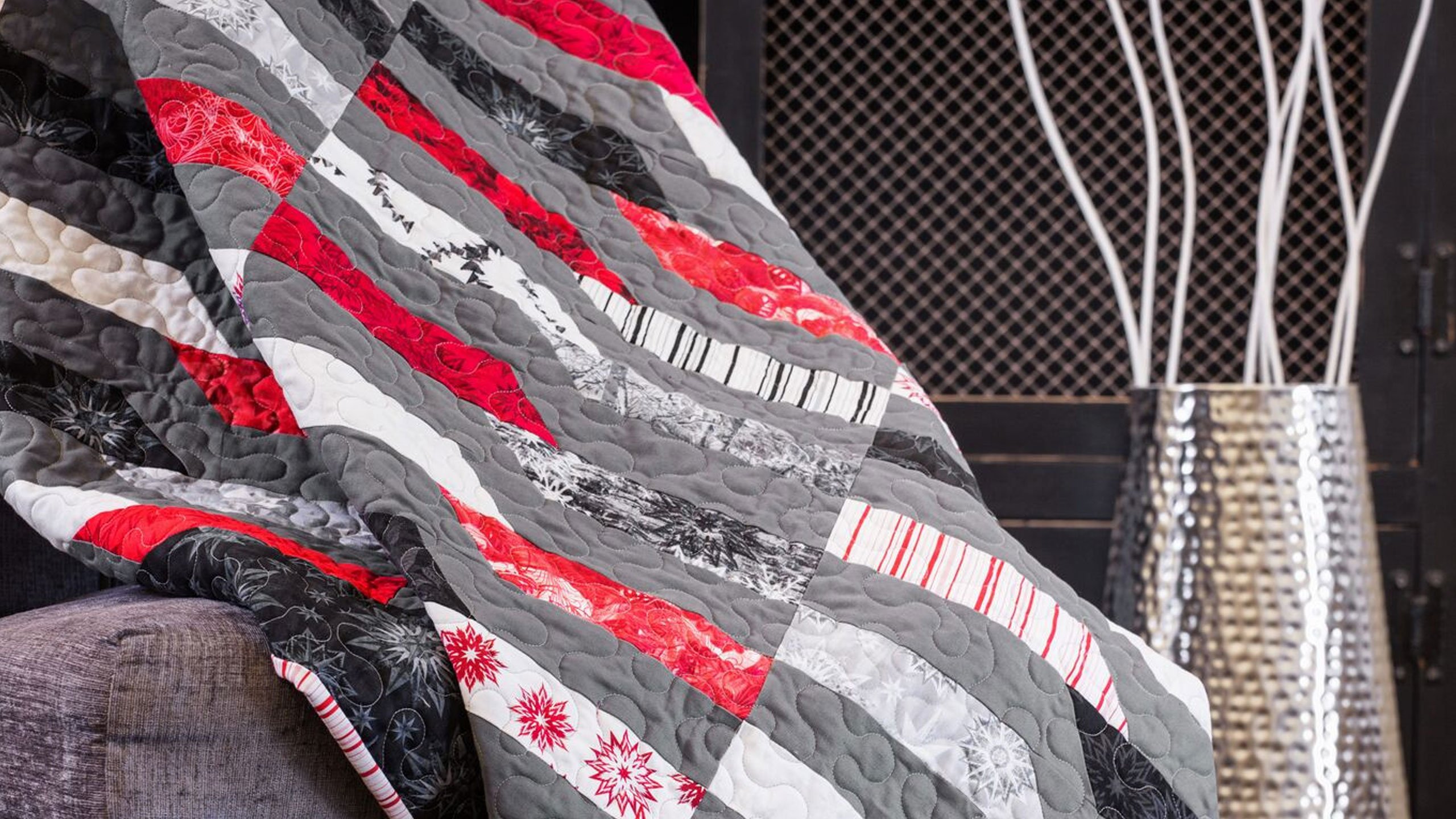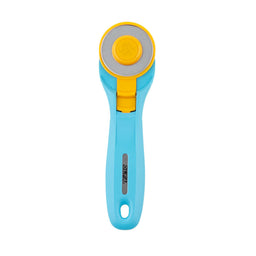Cascade Quilt Tutorial
Jenny Doan
Cascade Quilt Tutorial
- 1 roll x 2.5" Strips (Jelly Rolls) - Print
- 1 roll x 2.5" Strips (Jelly Rolls) - Solid
- 1-1/4 yards x Border Fabric
- 5-1/2 yards x Backing Fabric (44" wide)

Finish your masterpiece and let us give it the finishing touch it deserves.
Subscribe to MSQC on YouTube
Hundreds of FREE tutorials and a new one from Jenny launches every Friday.
video transcript
Hi everybody, it’s Jenny from the MSQC. And I’ve got a great project for you today. This quilt is made using one of my favorite tools, the binding tool. The binding tool is actually made by Susan Brown with TQM products. And this is the tool that taught me to bind correctly for the first time in my life. And so I’m real partial to this tool. But if you can use a tool like this for something else besides what it was meant for then it becomes this awesome bonus tool in your collection. And so we’ve made a quilt using this tool and let’s go take a look at it. Isn’t this fun? We’ve just used the binding tool, gives it this cascading look. I love this line of fabric. So to make this quilt what you’re going to need is one roll of 2 ½ inch strips of solid and one roll of 2 ½ strips of print. And again we’ve used the Forever collection which is just beautiful. You’re also going to need a little border fabric. We used a yard and a quarter for this great border. And take a look at this little binding. I love a stripe on the binding. It just, I just love how it looks. And for your binding you’re going to need ¾ of a yard. So let me show you how to make this because this is really fun and pretty simple.
Now there’s a couple of things you have to remember when making this quilt. You’re going to take our your strips and you’re going to open them all the way. All of your angles need to be going to same direction. And if we cut them with our strips folded, you’ll have angles going the opposite way and we don’t want that with this block. So what I did was I took my strips and I opened them up like this and then I just stacked them. So you’re still getting the same amount of cuts, you’re just going to, you’re just going to stack them up. So I’m going to mix some grays in here like this. And you can probably stack four. I would say four. If you have a super sharp blade you might want to go a little, you might be able to go a little more. But I like, I’m happy with about four. That’s good for me. Alright so now we’re going to take our binding tool and we’re going to line it up along the selvedge so that we’re cutting this straight edge off and getting rid of our selvedges all at once like this. And there we go. Now we’re going to come over here and we’re going to cut the angle. So then you’re going to come and make sure that little tip is cut off like that. And then you’re just going to turn your ruler straight around like this and cut off your end and cut off your point. Now you want to stack these on top of each other and you want to make sure that that angle is all going the same way. It should always go the same way with your print fabric so you want to make sure about that. And you’re going to cut your whole strip. Now when you’re ready to cut your gray strip, it doesn’t matter so much because you can use either side of these. And what we want to do is we want to make a block that looks like this.
So we’re going to take four of these and sew these to our gray pieces. And you’re going to sew them like this, ok? So you’re going to do that to four of these. And you can sew them all the same way and then you’re going to flip two over. So let me show you how to put these together. One, two, three, four. Alright now let’s go over to the sewing machine and let’s sew these together. When you sew these together, what you’re going to do is you’re going to line these up, the little. See the little notched edges, you want to line those up just like that. And then you’re going to sew your quarter of an inch right down the edge right there. And then you’ll open these up and they’ll be perfect angles. So the little notches help us line these up. So we’re going to lay these on here just like this. And we are going to sew these together. So we’re going to come over here. And we’re using a quarter of an inch seam right here. There we go. And let’s take a look and see how this looks. So see how that comes out nice and it’s nice and straight across. That’s because we used our notches to line that up and that makes a really good piece. Alright so I pressed that down. I’m going to go ahead and sew these together, lining them up using the notches just like this. And we’ll sew a few of these together over here. Alrighty, lined up on my quarter inch line. And once you get, once you get going on these you can actually chain piece them down because you’ve got your notches to make sure that, you know your little flat edges to make sure that it lines up there right. And so then you can chain piece them through. And that will speed up the process a little bit. Alright. Let’s see what we’ve got now. The other thing to remember about this is that if they’re off a little bit, they’re off a little bit don’t stress about that because, because if you can catch that in that quarter inch seam it won’t matter.
So then what you’re going to do is you’re going to flip these over like this. So let me show you again here. So these are lined up over here exactly the same you’re going to flip this over and it just lines up like that. And you’re going to do the same thing here. Let me see if I have another one here sewn together. Oh, I have a two. So let me iron this so you can see how this works. So here it is just like this. See how that comes together. It’s our same piece on here. So then what you’re going to do is you’re going to sew these two pieces together and then you’re going to sew these two pieces together so that it’s a four patch, a really long oddly shaped four patch if you will. But basically it’s a four patch and that just helps in putting your blocks together. It makes it go a little faster. Alright so I’m going to sew down the edge of this. And then I’m going to make sure that I’ve got these in the right places. And you always want it to be color, gray, gray, color. So opposites. So then we’ve got this here as well. I think I’ll turn this. There we go. So the gray is in the middle and I don’t have two fabrics that are the same by each other. And we’re going to lay this on that quarter inch line. Now remember sometimes this can be, you know, maybe doesn’t come out so it matches exactly and if that happens, as long as you can hide that in your quarter inch seam don’t worry about taking that out. Oops I just splashed a little bit on my block. Dry that up right there. And then this is your block like this.
Alright. So here’s some other blocks we’ve made. Now let’s take a look at the quilt behind me so we can see where to go next. So here’s our little four patch blocks like this. You can sew those together in a row like this. You can also sew them together in long columns. You’ll notice that they’re sewn together in long columns like this. So whatever works best for you. I did mine in rows like this. Just sewed them straight across. And then when you start adding that second row down here that’s where your cascading starts happening. Isn’t that cool? Alright so let’s see. We have got one, two, three, four, five, of these four patches on here and ten down. And that makes our quilt. And it makes a great size. I’m not sure if I said this already. But it’s like 77 by 89, close to 90 inches. So it’s a good size quilt. And it just goes together just so quickly and so easily. And just by using the binding tool. So we hope you enjoyed this tutorial on the Cascade Quilt from the MSQC.
& Progress on Social





